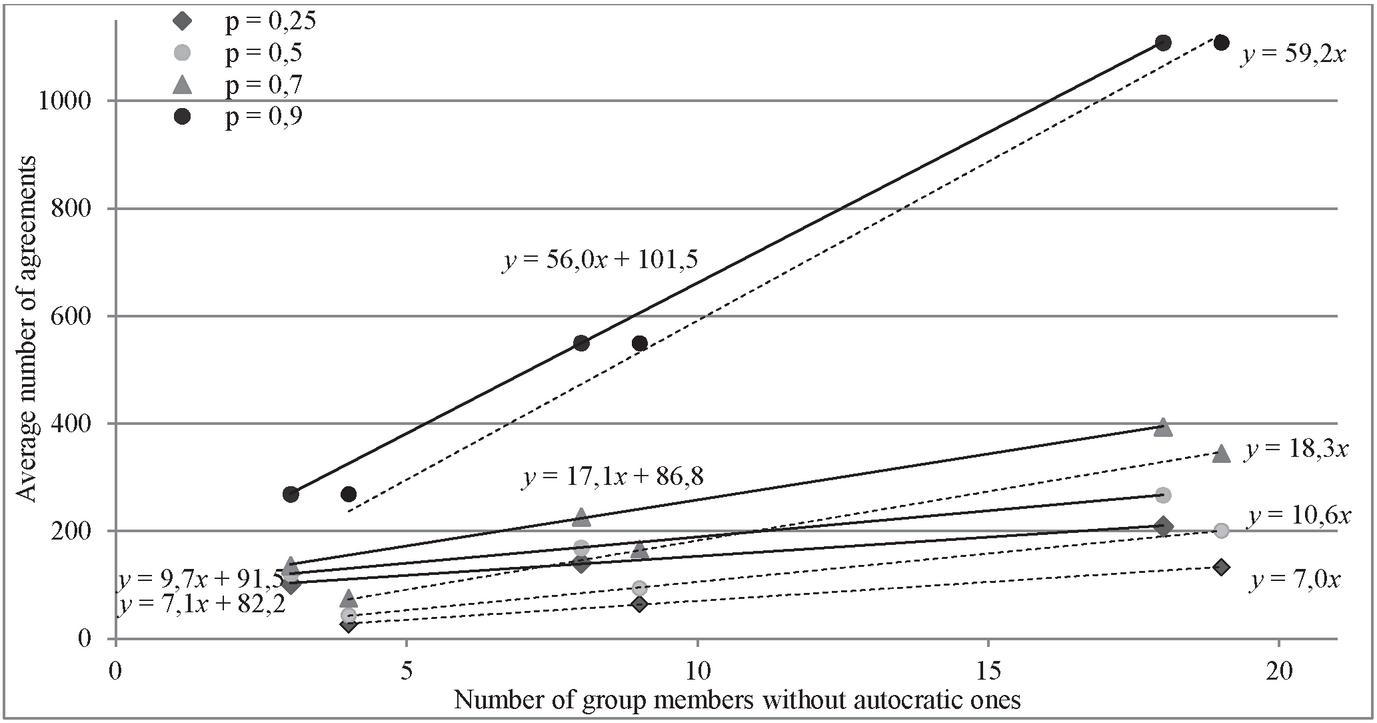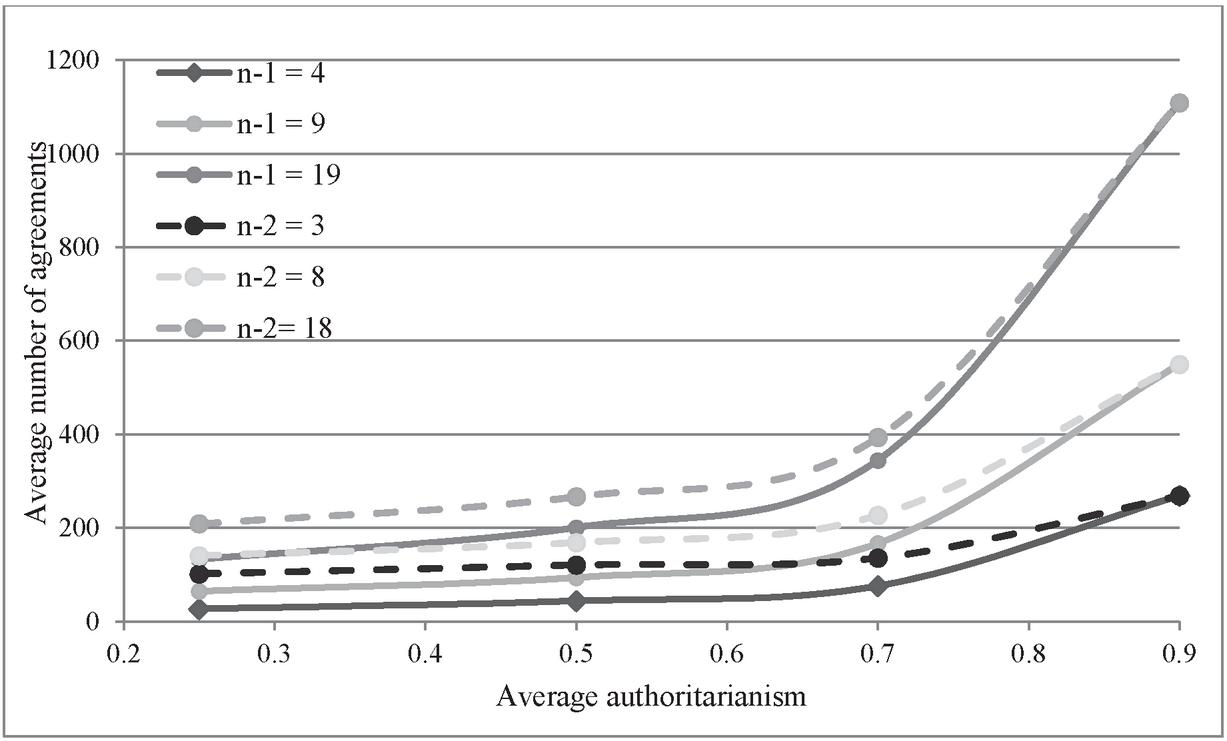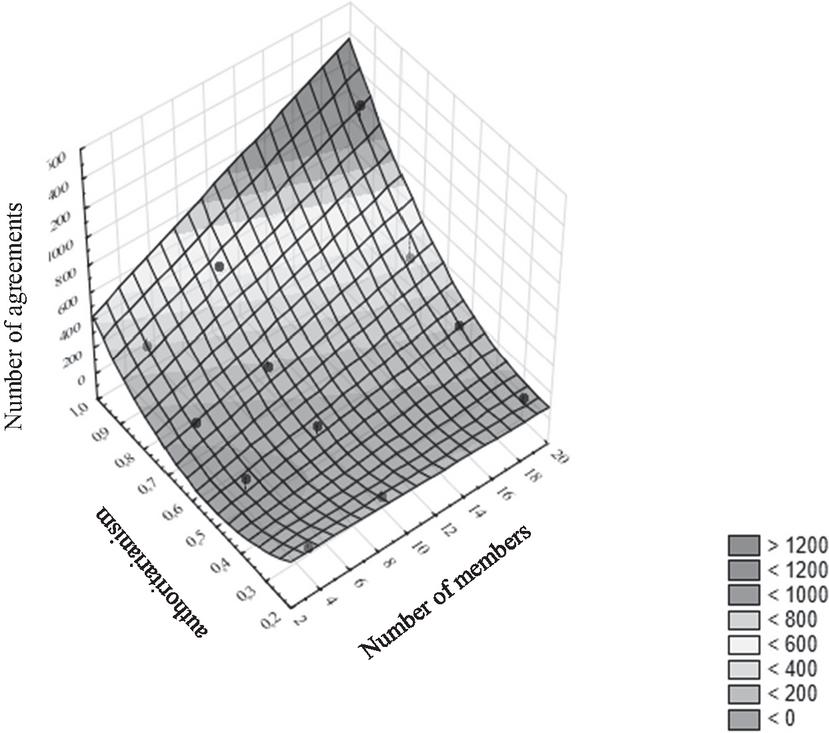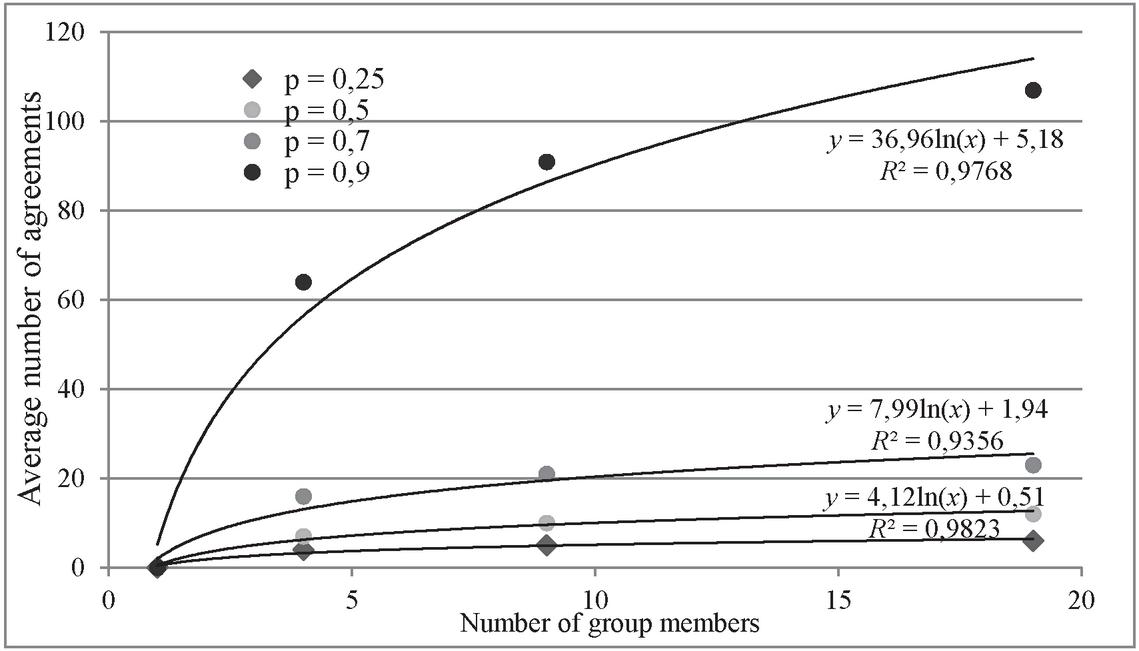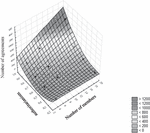Study of Decision-making Issues in Social Groups Based on Modelling of Incomplete Consensus
Olga V. Maksimova1, Iosif Z. Aronov2 and Ljubisa Papic3,*
1Candidate of Technical Sciences, Federal State Budgetary InstitutionYu. A. Izrael Institute of Global Climate and Ecology, Moscow Institute of Steel and Alloys, Russia
2Doctor of Technical Sciences, MGIMO (Moscow State Institute of International Relations) University of the Ministry of Foreign Affairs of the Russian Federation, Russia
3Doctor of Technical Sciences, Research Center of Dependability and Quality Management, Cacak, Serbia
E-mail: dqmcenter@mts.rs
*Corresponding Author
Received 10 September 2021; Accepted 26 January 2022; Publication 29 March 2022
Abstract
In many social groups, for example, in European eco-settlements, social movements (occupy), international organizations (WTO, OSCE, IPCC, etc.), decision-making is based on the consensus of the group members. Instead of voting, when the majority wins over the minority, consensus allows finding a solution that each member of the group supports or, at least, considers acceptable. This approach ensures that all the opinions of the group members, their ideas and needs will be taken into account. At the same time, reaching a consensus requires considerable time, since it is necessary to come to an agreement within the group, regardless of its size. It was shown that in some situations the number of iterations (agreements, negotiations) is very significant. Moreover, in the decision-making process, there is always a risk of blocking a decision by a minority in the group, which not only prolongs the decision-making time but even makes it impossible. As a rule, such a minority is presented by one or two odious people. Such a member of the group tries to dominate the discussion, always stands by his/her opinion, ignoring the position of the others. This leads to a protraction in the decision-making process, on the one hand, and a deterioration in the quality of consensus, on the other, since only the opinion of the dominant part of the group would be taken into account.In order to overcome this problem, it was proposed to make a decision based on the principle of “Consensus Minus One” or “Consensus Minus Two”, that is, not to take into account the opinion of one or two odious members of the group. For example, in climate researches, where many scientific disciplines are involved, a complete consensus is almost impossible.
Based on the simulation of consensus using the Markov chain model, the article studies the question of how much the decision-making time is reduced when using the “Consensus Minus One” and “Consensus Minus Two” rules, if the position of the dominant members of the group is not taken into account.
As it appears from the findings obtained, this paper can be in general summarized by saying that the rule of thumb applied for making a decision pursuant to the incomplete consensus principle has a solid mathematical background. The simulation results showed that its use can reduce the time required to reach a consensus to 97%, which is crucial for practice.
The average number of agreements hyperbolically depends on the average authoritarianism of the group members (excluding the autocratic members), which means that the negotiation process can be protracted at high values of the above-mentioned average authoritarianism.
Keywords: Consensus, incomplete consensus, social groups, consensus minus one, consensus minus two.
1 Introduction
The publication continues the series of articles devoted to the issues of reaching consensus in social groups (Aronov et al., 2018, 2019). Currently, in many international, regional and national technical committees for standardization, international organizations (WTO, OSCE, IPCC, etc.), European communities, social movements (for example, occupy), decision-making is based on the consensus of the group members.Instead of voting, when the majority wins over the minority, consensus allows them to find a solution that each member of the group supports or, at least, considers acceptable. This approach ensures that all the opinions of the group members, their ideas and needs will be taken into account. At the same time, reaching a consensus requires considerable time, since it is necessary to come to an agreement within the group, regardless of its size. In the works of the authors, the influence of various factors on the time of reaching consensus was studied by simulation method (Aronov et al., 2018, 2019). It was shown that in some situations the number of iterations (agreements, negotiations) is very significant. Moreover, in the decision-making process, there is always a risk of blocking a decision by a minority in the group, which not only prolongs the decision-making time but even makes it impossible.
As a rule, such a minority is presented by one or two odious people. Such a member of the group tries to dominate the discussion, always stands by his/her opinion, ignoring the position of the others (Johncon et al., 2012).
In order to overcome this problem, it was proposed to make a decision based on the principle of “Consensus Minus One” or “Consensus Minus Two”, that is, not to take into account the opinion of one or two odious members of the group. It is not for nothing that one of the consensus theorists in the social movement P. Gelderloos (Gelderloos, 2006) called such people “weeds”. Such a “weed” can be a dominant member of the group who ignores the opinions of the others.
In standardization, this approach has led to the formation of a new type of standardization documents – incomplete consensus documents. The effectiveness of these documents was manifested during the COVID-19 pandemic, when many foreign standardization bodies in order to accelerate the process began to develop standardization documents on personal protective equipment (for example, face masks) based on incomplete consensus standards instead of common consensus standards (Aronov et al., 2021).
Obviously, the “Consensus Minus One” or “Consensus Minus Two” rule reduces the decision-making time compared to the classical consensus principle, but how much?
To solve this problem, the authors undertook a corresponding study based on the mathematical method of Markov chains, which was described in a paper of scholars (Aronov, Maksimova, 2018, 2019) and which proved its suitability for simulations.
2 Theoretical Model for Achieving Consensus Based on Regular Markov Chains
In (Aronov et al., 2015), a theoretical model for achieving consensus based on regular Markov chains is described in detail. Here are the main results. Let n be the number of group members participating in the discussion; S(0) = (s;…;s) is the vector of the initial opinions of the group members, where s is the opinion of the i-th member. The participants in the negotiation process exchange opinions among themselves regarding the values of the S vector. The opinion of each of them may change during the negotiations. Introducing the probability of trust of the i-th participant to the opinion of the j-th participant through 0 p 1 (i 1,…,n; j 1,…, n) a square trust matrix P (), is formed, which sets the sequential process of agreeing the views of group members. The sum of the probabilities p in each row of the matrix is 1, i.e. for any the following is true. The vector of opinions of the group members at each step of the negotiations can be calculated by the formula
| (1) |
After the k-th step of negotiations, the vector of opinions can be calculated by the formula
| (2) |
The iteration process ends at the m-th step if all the rows of the matrix become the same. Thus, the trust matrix P after m iterations reaches the final F matrix (Kemeny and Snell, 1960). Due to the fact that the final matrix F does not change during subsequent iterations, the vector of opinions of the group members S(m) PS(0) (s,…,s, will not change either, i.e. the consensus is reached.
3 Study of the Incomplete Consensus Model
In (Aronov et al., 2015), the factors that affect the number of agreements before the consensus is reached, as well as the factors that affect the possibility of achieving it, are researched. Among the possible special cases in (Aronov et al., 2015), a case of dominance of one of the group members is specified, in which the negotiations are greatly protracted before the consensus is reached.
In the case when there is one autocratic participant1 (, p 1), there is an absorbing state in the trust matrix P, and it can no longer leave the iteration process (1) (Kemeny and Snell, 1960). Within the framework of negotiations, this means that the opinion of such a participant does not change as a result of agreements/iterations (in the final matrix F, it ispiielement that remains equal to one). It is difficult to convince such a member of the group, a consensus can be achieved only taking into account the opinion of this autocratic leader. Let’s consider an example a possible initial trust matrix P:
| (3) |
As a result of the iteration process described above, the initial trust matrix P will converge to the final matrix F of the following form:
| (4) |
In such a group, consensus is achievable. For example, with the initial trust matrix (1), it will take agreements to reach a consensus (under conditions of a given accuracy of the matrix elements , defined as the absolute difference for each j-th column for all rows (), which for such a small group is a long process. It is important that in this case, the consensus takes into account only the opinion of the autocratic leader, the opinion of the other members of the group is not taken into account in the final decision. In other words, the quality of consensus also degrades. If there is another autocratic member in the group in example (1), we get the following P matrix:
| (5) |
Such a matrix already contains two absorbing states (Kemeny and Snell, 1960). Matrices of this type and their corresponding Markov chains are expanding (Gantmacher, 2004). Since the product (and, accordingly, the degree) of expanding matrices is an expanding matrix, it is obvious that in this situation consensus is not achievable (for any n 2). In the literature on group dynamics, similar conclusions are made when it comes to the presence of several autocratic group members (Myers, 2010). Therefore, for further research of decision-making based on the “Consensus Minus Two” rule, we will consider a model with one absolutely autocratic member (leader) and a second member with a high level of authoritarianism, which is though not equal to one.
It is possible to solve the current situation with the protraction of negotiations by their reorganization, which can be performed in various ways:
(1) replacement of autocratic members;
(2) ignoring the opinions of autocratic members in the group when making a decision.
The second approach is more common (we will call it “consensus minus k”) since it does not require additional resources to find a new member of the group and gives a significant reduction in the number of agreements. For the trust matrix (1), after the removal of the autocratic leader, the number of agreements in the group is reduced to m 4, i.e. it is reduced by 86% compared to the initial m 29. Therefore, presence of even one ambitious member in the group should be suppressed, since the opinion of this particular participant will prevail, and the negotiation process will be protracted.
Next, we will discuss the analysis of reducing the time to reach consensus in case ignoring the opinions of autocratic members of the group, i.e., the situation of making a decision according to the “Consensus Minus One” or “Consensus Minus Two” rule.
Next, we will focus on the analysis of procedures allowing to reduce the consensus-building time given that we disregard the opinions delivered by autocratic group members, namely, we will discuss the decision-making process based on the “Consensus Minus One” or “Consensus Minus Two” rule.
4 Time Required to Reach a Consensus When There is One or Two Autocratic Group Members
Let us to build a mathematical model of dominance using the example of 20 members of a social group. The paper (Zazhigalkin et al., 2019) testifies to the fact that this number of members is optimally appropriate in terms of the number of agreements before a consensus, provided that all other conditions are the same.
Let us estimate the time of the opinion matrix P required for it to converge to the final matrix F P. This time is determined by the necessary number of iterations (discussions among social group members) to build a consensus. Mathematically, is defined as the degree of the matrix , at which the elements within each column of the final matrix meet the common condition for all (). To calculate the m value, we will refer to the condition .
So, we consider two cases of simulation:
1. , where n stands for the “number of social group members”, stands for the “number of agreements before a consensus” (i.e., the time required to reach a consensus), there is one leader running the group.
2. , where n stands for the “number of social group members”, stands for the “number of agreements before a consensus”, there is one leader running the group and also one profoundly autocratic member, since one more member who shows the ultimate level of autocracy would prevent from reaching a consensus.
Each simulation process consisted of several stages:
At the first stage, we chose the levels of change in the number of group members ():
1: ;
2: ;
3: .
At the second stage, we suggested the probability to set the likelihood of the participant’s confidence in themselves (so-called “the level of authoritarianism”). When it comes to the leader, is 1; we use for profoundly autocratic members . For other group members, please see the levels of authoritarianism presented below:
1: ;
2: ;
3: ;
4:
If the level of authoritarianism reaches almost 1, the person concerned is unlikely to be prone to compromise, and if the value is around 0, is typical of a conformist who does show a volatile position while negotiating, and, therefore, they are inclined to drift toward other people’s opinions than to own ones. Behavioural patterns of different group members were reflected in the conditions for simulation .
At the third stage, we simulated the elements of the matrix P for each level n. For this purpose, we used the uniform law of distribution law under the given conditions so that the sum of the probabilities within each line did equal 1. In order to draw robust conclusions about the average number of agreements m against the backdrop of other parameters changing, there were 100 simulations conducted in the Excel environment for each level of factors (Efron and Tibshirani, 1991).
We have already pointed out that the consensus will take into account only the leader’s opinion, if there is one in the group. Therefore, we will further investigate the relationship between the number of agreements and the number of members whose opinion is not taken into account in the resulting decision. Fig. 1 shows the dependences of the number of agreements (iterations) on the number of group members excluding as autocratic group members when . We may conclude that the number of group members affects the number of agreements before a consensus strongly given that there are autocratic members present, which is consistent with the findings obtained previously (Zazhigalkin et al., 2019).
Figure 1 Dependence of the average number of agreements m on the number of group members for different levels of authoritarianism : the “Consensus Minus One” model does not take into account one autocratic group member (linear trends are marked as “”), the “Consensus Minus One” model does not take into account two autocratic group members (linear trends are marked as “”).
In order to present the average number of agreements on different levels of trust (please see the second stage of simulation for details), we built appropriate linear regression dependencies, which have the following form (Tukey, 1977).
| (6) |
where stands for the “regressive number of iterations required to reach a consensus”, () stands for the number of group members excluding autocratic ones (), stand for regression coefficients of the equation. It stands to reason that the “Consensus Minus One” model, if there are no other members (i. e. ), does not provide any agreements in contrast to the “Consensus Minus Two” model implying that, in presence of two autocratic members, the ultimately autocratic one has to score several numbers of agreements to pull the other one to their side. Therefore, for the “Consensus Minus One” model, regression dependencies (2) contain a zero intercept (, see Figure 1). The analysis of the model (2) attests not to only visual, but also theoretical good alignment with the simulation data (for each straight line, the coefficient of determination is ). It is evident that the number of agreements in the presence of two autocratic members is, on average, greater than in the presence of one, provided that other parameters are equal (Figure 1).
Given that the model is of high quality, Equation (2) allows deducing the average number of agreements per one member for groups with one leader. This number is set by the coefficient ; we may analyze its growth when the average authoritarianism of the group members changes. In terms of consensus, this number can be interpreted as a “specific” number of agreements. For example, if the authoritarianism of the group members is , the specific number of agreements equals 7. However, if is the case, it increases to 59, i.e., almost 9 times (Figure 1), which indicates a marked jump in the total number of agreements and a significant protraction in the negotiation process.
The graphs in Figure 2 illustrate the high sensitivity of the number of agreements m to the average authoritarianism of the members and reveal a hyperbolic connection when the average authoritarianism approaches to 1. This suggests a possible sharp increase in the number of agreements when building a group with autocratic members.
Figure 2 Dependencies of the average number of agreements m on the average authoritarianism of group members for different numbers of members without taking into account one authoritarian for members when .
Figure 3 3D imaging of the model that presents the dependencies of the average number of agreements on the number of group members (if there is one autocratic member).
As for the model with one leader, the graphs obtained in Figures 1 and 2, as well as the regression dependences make it possible to build up a generalized 3D model, the graphic visualization of which is shown in Figure 3:
| (7) |
stands for the average number of agreements, stands for the number of group members (excluding the autocratic leader), is average authoritarianism of group members (excluding the autocratic leader).
The resulting model gives a high level of approximation () and allows performing a point estimate of the average number of agreements under the given conditions (Figure 3). Let us assume that there are 20 participants gathered to agree on the project, among whom there is one leader, and the average authoritarianism of the remaining members is . In this case, according to model (3), we might expect an average of 1041 agreements before a consensus, which gives evidence of an unacceptably long negotiation process of several years. One of the possible solutions, as described in paragraph 1, is to remove the leader from the decision-making process. Further, we will focus on the analysis of this method that is likely to reduce the number of agreements required to make a decision in the relevant group.
5 Time to Reach a Consensus against the Backdrop of the Autocratic Members Being Excluded
Paragraph 3.1 lists the conditions and stages of simulation in the presence of autocratic members. The same stages will be followed when modelling the “Consensus Minus ” situation. In this case, we have a group without autocratic members. Figure 4 shows the graphs based on the simulation results for the average number of agreements under these conditions. Compared to the dependencies presented in Figure 1, the situation at hand shows a slow increase in the number of agreements along with an increase in the number of group members (provided that all other conditions are the same), which is well approximated by a logarithmic dependence (Figure 4). Moreover, such an increase in the average authoritarianism in the group results in the coefficients of the logarithmic function rising against this background, which indicates an increase in the average number of agreements.
Figure 4 Dependence of the average number of agreements m on the number of group members at different average levels of authoritarianism without autocratic members.
Table 1 Simulation results for the average number of agreements m in the incomplete consensus model before and after the removal of autocratic group members
| Average Number of Agreements m | Reduction in the Number of Agreements | ||||||
| Number of Group Members n | Average Authoritarianism of Group Members | If There is One Autocratic Member | After the Removal of One Autocratic Member | If There are Two Autocratic Members | After the Removal of two Autocratic Members | “Consensus Minus One” Model, % | “Consensus Minus Two” Model, % |
| 5 | 0.25 | 27 | 4 | 102 | 3 | 85 | 97 |
| 5 | 0.5 | 44 | 7 | 121 | 5 | 84 | 96 |
| 5 | 0.7 | 76 | 16 | 136 | 11 | 79 | 92 |
| 5 | 0.9 | 269 | 64 | 269 | 46 | 76 | 83 |
| 10 | 0.25 | 65 | 5 | 141 | 5 | 92 | 96 |
| 10 | 0.5 | 94 | 10 | 169 | 9 | 89 | 95 |
| 10 | 0.7 | 167 | 21 | 227 | 19 | 87 | 92 |
| 10 | 0.9 | 550 | 91 | 550 | 82 | 83 | 85 |
| 20 | 0.25 | 133 | 6 | 209 | 6 | 95 | 97 |
| 20 | 0.5 | 201 | 12 | 267 | 12 | 94 | 96 |
| 20 | 0.7 | 345 | 23 | 394 | 23 | 93 | 94 |
| 20 | 0.9 | 1109 | 107 | 1109 | 105 | 90 | 91 |
The findings presented in the table show that the additional substitution of one autocratic member () with a representative typical for the group already allows in some cases for reducing the number of agreements by almost 4 times, even in the presence of a leader. The removal of the ultimately autocratic member from the decision-making process entails a sharp decrease in the number of agreements before a consensus.The simulation results summarized in the table speak for the fact that this decrease in the “Consensus Minus One” model might vary in the range of 76–95%, and, as for the “Consensus Minus Two” model, this value lies between 83 and 97%.
6 Conclusion
As it appears from the findings obtained, this paper can be summarized in general by saying that the rule of thumb applied for making a decision pursuant to the “Consensus Minus ” principle has a solid mathematical background. The results obtained through the simulations of decision-making processes driven by the “Consensus Minus One” or “Consensus Minus Two” rule associated with the removal of one or two autocratic group members, can reduce the time required to reach a consensus to 97%, which is crucial for practice.
The average number of agreements m hyperbolically depends on the average authoritarianism of the relevant group members (excluding the autocratic member), which means that the negotiation process can be protracted at high values of the above-mentioned average authoritarianism.
The expression (3), which approximates the dependence of the average number of agreements on the average authoritarianism of group members in the presence of one leader, makes it possible to estimate the average time required to reach a consensus and form the necessary group more objectively (in a directed manner).
Conflict of Interest
The authors confirm that there is no conflict of interest to declare for this publication.
Acknowledgments
The authors would like to thank the editor and anonymous reviewers for their comments that help improve the quality of this work.
References
Aronov I.Z., Maksimova O.V. (2015). Theoretical modeling consensus building in the work of standardization technical committees in coalitions based on regular Markov chains. Computer Research and Modeling, 12–5, 1247–1256.
Aronov I.Z., Maksimova O.V., GrigoryevV.I. (2018). Analysis of Consensus-Building Time in Social Groups Based on the Results of Statistical Modeling. Netherlands. River Publishers, 1–31.
Aronov I.Z., Rybakova A.M., Galkina N.M. (2021). Peculiarities of Technical Measures During the COVID-19 Pandemic. Use of AI, Robotics, and Modern Tools to Fight Covid-19. River Publishers, 215.
Efron B., Tibshirani R. (1991). Statistical Data Analysis in the Computer Age.Science, New Series, 253. –5018, 390–395.
Gantmacher F. R. (1959). The Theory of Matrices. AMS Chelsea Publishing: An Imprint of the American Mathematical Society, 660.
GelderloosP. (2006). Consensus: A New Handbook for Grassroots Political, Social and Environmental Groups. See Sharp Pr, 120.
Kemeny J. G., Snell J. L. (1960). Finite Markov chains. The University Series in Undergraduate Mathematics. – Princeton: Van Nostrand.
Myers D. (2010). Social Psychology. The MCGrow-Hill Companies, Inc., 759.
Sheril L., Johncon L., Leedom J., Muhtadie L. (2012). The Dominance Behavioral System and Psychopathology: Evidence from Self-Report, Observational, and Biological Studies. Psychol. Bull, 138(4), 692–743.
Tukey, J. W.(1977). Exploratory Data Analysis. Addison-Wesley, Reading, 506.
Zazhigalkin A. V., Aronov I. Z., Maksimova O.V., Papic L. (2019). Control of consensus convergence in technical committees of standardization on the basis of regular Markov chains model. Springer India: International Journal of Systems Assurance Engineering and Management, 1, 1–8.
Biographies

Olga V. Maksimova is a mathematician, associate professor at the National University of Science and Technology MISIS in Moscow, a leading researcher at the Yu. A. Israel Institute for Global Climate and Ecology since 2019. In 2012, she received her PhD in the application of statistical methods in quality management. Maksimova graduated with honors from the Faculty of Mathematics of Ivanovo University in 2000. Since 2001, she has worked as an assistant professor at the National Energy Research University in Moscow. Since 2008, she has been working as a business coach on the application of statistics and optimization methods in practice at the university. Maksimova has been conducting scientific research in the field of mathematical modeling of consensus since 2012, participating in scientific projects and conferences on climate research.

Iosif Z. Aronov is a professor at the Moscow State Institute of International Relations (University) in Moscow, the adviser of Director General of Russian Institute of Standardization. In 1999, he received his Doctor of Science in the application of statistical methods in safety management. Aronov graduated from the Faculty of Mechanics and Mathematics of Moscow State University in 1970. Since 1971, he has worked as a senior as a senior researcher, head of the reliability and safety analysis department in research institutes. Aronov has been conducting scientific research in the field of mathematical modeling of consensus since 2012 in collaboration with O. V. Maksimova and L. Papic.

Ljubisa Papic is professor at Peter the Great St. Petersburg Polytechnic University, St. Petersburg, Russia and director and founder The DQM Research Center, Prijevor, Serbia, corresponding member of Academy of Engineering Sciences of Serbia, academician of Russian Quality Problems Academy, and past assistant minister of Ministry of Science, Technology and Development in Government of Republic Serbia. He was visiting professor at: Ben-Guriona University of the Negev (Israel), Valencia Polytechnic University (Spain), Samara State Aerocosmic University (Russia). He is author more than 450 scientific papers, seminar publications, reports and books in system effectiveness, reliability engineering, maintenance, safety and quality, lean production. During 25 years he is chair of International scientific programme committee two annual DQM conferences: “Dependability and Quality Management” and “Life Cycle Engineering and Management”, whose organizer is DQM Research Center, Prijevor-Cacak, Serbia. He is Editor-in-Chief of Communications in Dependability and Quality Management, An International Journal.
Journal of Graphic Era University, Vol. 10_1, 51–68.
doi: 10.13052/jgeu0975-1416.1015
© 2022 River Publishers
